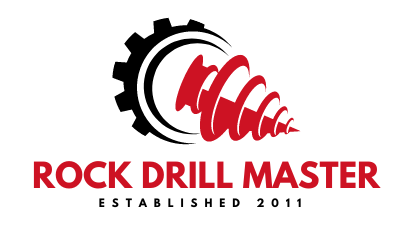Selecting the proper down-the-hole drill bit can mean the difference between a smooth, efficient drilling operation and one plagued with slow progress and high costs. But with so many bit designs and sizes available, how do you choose the right DTH drill bit for your specific project? In this article, we’ll walk through the key factors to consider – from rock type to equipment compatibility – and provide a step-by-step approach to help you make an informed decision.
(Best Practices for Maintaining DTH Drill Bits) Assortment of DTH drill bits in inventory, highlighting the range of diameters and configurations available to choose from.
1. Identify Your Ground Conditions
The first and most important factor is the geology you’ll be drilling into. Different rock or soil conditions demand different bit characteristics:
- Rock Hardness: Is the formation soft (like limestone or claystone), medium (sandstone), or hard (granite or basalt)? Harder rock typically requires more robust bits. For example, in very hard rock you might choose a flat or convex faced bit with spherical buttons for durability (DTH Drill Bits – Mincon) (DTH Drill Bits – Mincon). In softer rock, a concave bit with sharper (ballistic) buttons can drill faster.
- Rock Abrasiveness: Highly abrasive rocks (some sandstones, quartz-rich granites) wear down bits quickly. Here, tougher button shapes and perhaps hardfacing on the bit body are important to reduce wear (preventing “body wash”). If the rock is not very abrasive, you have more freedom to use aggressive designs.
- Fractured or Competent Formation: A fractured or broken formation might cause drill bits to deviate or get stuck. Concave bits, or bits with guide stabilizers, help maintain straightness in those conditions. In very competent (solid) rock, straightness is easier to maintain, so you can focus purely on penetration performance.
- Presence of Water: Wet conditions or groundwater can affect hole cleaning. Some bits have extra flushing holes or larger passages for better removal of cuttings if water is present. If you anticipate water, ensure the bit/hammer system can handle it (or consider a water-powered DTH hammer).
- Overburden (Soil) Layer: If you need the bit to drill through some overburden before hitting rock, a bit that can handle both (like a dome-shaped or steep convex that won’t be damaged by a brief soil section) could be useful. Alternatively, you might use a separate method (like a casing shoe or drag bit) for the overburden, then switch to DTH in rock.
Tip: Obtain a rock core or detailed geologic report if possible. Knowing the unconfined compressive strength (UCS) of the rock or its drillability class can directly guide bit selection charts from manufacturers. For instance, a rock hardness of 250 MPa suggests using the toughest button style available.
2. Define the Hole Diameter and Depth
Next, clarify the hole size and depth required by your project:
- Required Hole Diameter: DTH drill bits come in diameters typically ranging from ~3 inches (75 mm) up to 30+ inches (760+ mm) for very large applications. The bit diameter you need is usually determined by the project (e.g., a 6″ borehole for a water well casing, or a 4″ hole for blasting). This immediately narrows your options to bits that fit that size. Also, the hole diameter dictates the hammer size you’ll use (e.g., a 6-inch bit might run on a 5-inch class hammer). Ensure your drill rig and hammer can accommodate the chosen diameter.
- Drilling Depth: How deep must you drill? Depth matters because deeper holes require more drill pipe and greater flushing capability. DTH bits are well-suited for deep holes because they maintain energy at depth. However, extremely deep holes may benefit from certain bit features:
- Long gauge length (the length of the bit’s outer gauge surface) can help keep deep holes straighter.
- If drilling very deep (>200m), consider bits that are proven for deep-hole straightness (often convex or flat designs for stability).
- Ensure the air compressor can deliver enough volume at depth for cuttings removal – if not, a bit with extra flushing holes or a smaller diameter (to reduce air needed per volume of hole) might be chosen.
- Hole Trajectory: Is it a vertical hole or angled? For angled holes (e.g., rock anchors, dewatering holes), you might prioritize bits known for good directional control (again, concave face or even special steerable bits if needed).
3. Match the Bit to Your DTH Hammer and Rig
It’s crucial that the bit is compatible with your equipment:
- Shank Design: DTH bits have various shank types (spline configurations) that mate with corresponding hammers (e.g., COP, DHD, QL, Mission, etc., are common shank standards). Verify the hammer model you’ll use and choose a bit with the matching shank. For instance, if you have a 5” Sandvik hammer that uses a DHD340 shank, you need bits of that shank type in your chosen diameter.
- Hammer Size and Air: The hammer’s size (and your rig’s compressor) will dictate feasible bit sizes. As a rule, the smallest hole a DTH hammer can drill is about the hammer’s diameter plus a bit of clearance. Conversely, maximum hole size is maybe 25% larger than hammer diameter. Using a too-small hammer with a large bit will be inefficient. Always pair a hammer size appropriate for your hole diameter for optimal performance (DTH Drill Bits – Mincon).
- Rig Capabilities: Check your drilling rig’s specs:
- Can it produce the required rotary torque for the bit? Larger bits and harder rock need more torque.
- Is the feed force (weight on bit) sufficient? Hard rock drilling requires a certain bit pressure. If your rig is lighter duty, you might choose a bit that drills with lower thrust (some bit designs claim better performance with less weight).
- Do you have enough air pressure and volume? DTH hammers often have recommended operating pressure (e.g., 300 psi/21 bar). At a given pressure, larger bits need more air volume (cfm or m³/min) to clear cuttings. If your compressor is a limiting factor, you might opt for a slightly smaller bit or a bit with optimized flushing to work with lower air.
- Rotation Speed: Different bit types sometimes prefer different rotation speeds (RPM). Hard rock bits run slower RPM with high impact, softer rock bits run faster. Ensure your rig can adjust accordingly.
Compatibility Check: Always confirm the bit’s shank and size with your hammer model. For example, a “5-inch class” DTH bit might actually measure ~5.5 inches diameter and fit a 5” hammer – these details can be found in manufacturer catalogs. Mismatched shanks simply won’t physically connect, and an undersized compressor will struggle to power a large bit.
(DTH Drill Bits for Precision Drilling | Rock drill bits | Drill King) A DTH drill bit attached to its hammer. Always ensure the bit’s shank design matches your hammer model, and that your rig can provide sufficient pressure and rotation for the chosen bit size.
4. Consider Project Objectives and Constraints
Think about what you’re trying to achieve and any specific constraints:
- Speed vs. Tool Life: If you need to drill very quickly (perhaps to meet a deadline or drill many meters per day), you might choose a more aggressive bit (e.g., ballistic inserts) accepting that it may wear out faster. On the other hand, if minimizing bit consumption is crucial (remote site or expensive bits), a slightly slower but longer-lasting design could be better (like spherical inserts that don’t wear as fast (DTH Drill Bits – Mincon)).
- Hole Quality: Do you need exceptionally straight or smooth-walled holes? For example, piling or anchor holes often must be straight and on-grade. Bits known for straight drilling (concave or convex designs as discussed) would be chosen over perhaps a faster, looser-tracking bit. If wall quality is important (to hold casing or grout), a bit that gives good gauge control and doesn’t wobble is needed.
- Ground Risk Factors: If the area is known for stuck bits, maybe choose a bit with a retrievable design or cross-over capabilities. Some projects use a sacrificial bit or ring bit with casing – if that’s your case, selection is a bit different (you’d follow the casing system’s guidelines).
- Cost Considerations: While we all want the “best” bit, cost is a factor. A premium bit may outperform a cheaper one significantly, but you need to ensure the extra drilling speed or life justifies the price. Weigh the upfront cost against expected lifespan in the given ground (sometimes a more expensive bit that lasts 2-3 times longer is worth it). We’ll explore cost vs performance more in a later section, but keep it in mind during selection.
5. Use Manufacturer Guidance and Past Experience
Reputable DTH bit manufacturers provide selection charts or guides. Once you know the factors above (rock type, hardness, hole size, etc.), consult these resources:
- Selection Charts: These often recommend a bit face and insert type for a given rock hardness/abrasiveness. For example, a chart might say “Hard, abrasive rock -> Flat face, spherical inserts (Product X)”.
- Product Lines: Manufacturers have bit series optimized for certain conditions (e.g., “Fast Drill” series, “LongLife” series). Align your needs with these descriptions.
- Talk to Experts: Don’t underestimate the value of experience. If you or colleagues have drilled similar ground before, what bit worked? Local drillers or suppliers might know which bits have a good track record in that area.
- Testing: If feasible, you might start with two different bit types (from two brands or two designs) to see which performs better in your specific job. Monitor their penetration rate and footage achieved per bit. This real-world data will quickly tell you the best choice.
6. Step-by-Step Selection Recap
To summarize, here’s a quick step-by-step approach:
- Determine hole diameter and depth required -> shortlist appropriate hammer size and corresponding bits.
- Analyze rock conditions (hardness, abrasiveness, fracturing, water) -> note key demands (durability vs aggression, flushing needs).
- Choose face design and carbide type that best suits the ground (use Table 1 above or manufacturer chart as a reference).
- Verify compatibility: bit shank with hammer, hammer size with rig & compressor. Eliminate any options that your equipment can’t handle.
- Consider project priorities: fast drilling vs low wear vs straightness, etc., and pick a bit that balances these for you.
- Consult manufacturers for specific models in the design you’ve settled on, and check reviews or case studies if available.
- Monitor performance once drilling starts. If the bit isn’t performing as expected (too slow or wearing too fast), be ready to switch to an alternative if possible.
(Maintain DTH Drill Bits: Prevent Body Wash & Extend Lifespan) Example of a DTH bit chosen for a specific project – this green bit has a concave face and mixed-shaped buttons, ideal for medium-hard, slightly fractured rock where straightness and speed are both needed.
Conclusion
Choosing the right DTH drill bit might seem complex, but by systematically considering your project’s geology, technical requirements, and goals, the “best fit” bit will become clear. The right bit maximizes drilling efficiency, reduces downtime, and ultimately saves money by completing the project faster and with fewer replacements. Whenever in doubt, reach out to bit suppliers with your detailed requirements – they can often recommend a specific model tailored to your needs. With careful selection and a bit of expert advice, you’ll drill through your project with ease and confidence.






